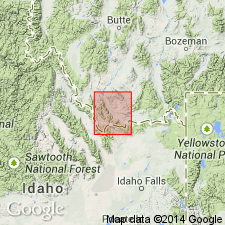
- Usage in publication:
-
- Muddy Creek volcanics, beds
- Modifications:
-
- First used
- Dominant lithology:
-
- Tuff
- Shale
- Conglomerate
- Limestone
- AAPG geologic province:
-
- Montana folded belt
Summary:
First published use of name as Muddy Creek volcanics and Muddy Creek beds. Name applied to white, gray, pink and buff acidic tuffs interbedded with shale, conglomerate, freshwater limestone, in Muddy Creek and Muddy Hole basins, west of Lima, Beaverhead Co, MT in the Montana folded belt province. Exposures are poor. Mapped in two major belts (geologic map) at west-central part of area. No type locality designated. Is mostly white, gray and buff; has some pink, red, brown, and black beds. Estimated as 1,000 ft thick. Freshwater gastropods, bedding, and laminations indicate water-laid origin. The tuffs are rhyolitic with quartz, sanidine, oligoclase, and biotite embedded in glass; accessory minerals in the tuffs are zircon, apatite, chlorite, calcite, allanite? and magnetite. Considered to be middle Oligocene age; younger than the Sage Creek formation, correlative with the Cook Ranch formation, and older than the Medicine Lodge volcanics. The Medicine Lodge-Muddy Creek contact is difficult to locate. Stratigraphic chart.
Source: GNU records (USGS DDS-6; Denver GNULEX).
For more information, please contact Nancy Stamm, Geologic Names Committee Secretary.
Asterisk (*) indicates published by U.S. Geological Survey authors.
"No current usage" (†) implies that a name has been abandoned or has fallen into disuse. Former usage and, if known, replacement name given in parentheses ( ).
Slash (/) indicates name conflicts with nomenclatural guidelines (CSN, 1933; ACSN, 1961, 1970; NACSN, 1983, 2005, 2021). May be explained within brackets ([ ]).

